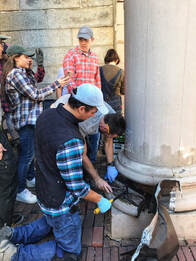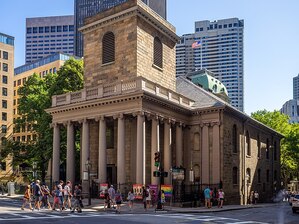|
By Mitchell Bryan, Historic Site Educator As a society, we are drawn to the ancient, the historic, and the antique. Places and objects from long ago help us connect with and understand our past, but they also shape the present and inform our future. Although new construction constantly changes the face of our country, people are still driven to preserve history rather than abandon or destroy it. In the United States, historic preservation is conducted at the grassroots level. As a response to urban renewal and the destruction of historic buildings and sites nationwide, people now make the conscious decision every day to preserve places that are important to them, their families, and the broader communities in which they live. They are aided by laws and programs that ensure historic places are maintained for future generations. This is known as the Historic Preservation Movement.  A typical plaque found on properties listed in the National Register of Historic Places. A typical plaque found on properties listed in the National Register of Historic Places. The single most important piece of legislation behind historic preservation in the United States is the National Historic Preservation Act (NHPA). Passed by Congress in 1966, this act formalized the existing efforts of thousands of communities to preserve the nation’s history. It stipulated that each state must have its own historic preservation office to guide preservation programs, and created the National Register of Historic Places — a list of sites nationwide deemed worthy of recognition and preservation for their significance to national history. In the years following the passage of the NHPA, the King’s Chapel community chose to put forth their historic church for nomination and join the growing number of sites listed on the National Register. But how exactly was this achieved? Every National Register listing begins at the individual level. When a person or group decides they want to preserve and protect a place that is significant to them, they must first fill out the nomination form, a document designed to focus and compile important information about the site’s history and significance. The nomination form for King’s Chapel was prepared by Patricia Heintzelman, an architectural historian who worked for the Historic Sites Survey, the precursor to the National Historic Landmark program. In 1960, King’s Chapel was designated a National Historic Landmark and automatically qualified for listing on the National Register based on this status. In order to fully meet the requirements, however, the stone chapel had to fit at least one of the following four criteria: association with broad events of American history, association with significant people, retention of architectural significance, or the potential to yield archaeological information. King’s Chapel could have been nominated based on any one of these criteria, but Heintzelman chose to focus, understandably, on the architectural history of the chapel. She passionately argued that King’s Chapel is historically significant because it is the first Anglican congregation in New England and one of, if not the first, important stone buildings in Boston. Heintzelman also stated that the chapel’s Georgian Palladian architecture is an example of “mastery of space composition” and “a sure sense of grandeur and scale.” The nomination form contains a brief history of the congregation and the architect Peter Harrison, who designed the 1754 stone chapel. Heintzelman also included several documentary photographs and a statement of significance to further illustrate why King’s Chapel should be added to the National Register. After completing the form in 1967, the next step was submission to the State Historic Preservation Office, the Massachusetts Historical Commission (MHC). Not only do organizations like the MHC serve as the intermediary between nominators and the National Register committee, but they also collect and preserve valuable historical information for sites statewide. Once King’s Chapel’s nomination was sent to the MHC, it was reviewed and sent to the National Register for official submission. On May 2, 1974, King’s Chapel was officially added to the National Register of Historic Places. While efforts to maintain the historic building existed long before its nomination, King’s Chapel became more eligible for protection being listed on the National Register. Now more than ever, the local, state, and federal support for preservation programs allow places listed on the National Register to seek grants to maintain their historical and architectural integrity. A listing on the National Register opens up doors for preservation aid, but does not necessarily ensure its preservation. The responsibility to preserve ultimately remains in the hands of everyday people.  Students from North Bennett Street School patch the exterior columns in 2019. Students from North Bennett Street School patch the exterior columns in 2019. Preservation at King’s Chapel is an ongoing task. Structural preservation and repairs are undertaken to ensure the chapel retains its historic architectural style, including a large restoration project to restore the exterior in the 1990s. The history program offers a number of incredible tours that highlight the history of the chapel and the people associated with it. And today, King’s Chapel is an active congregation, just as it was in the past. These actions preserve the history of King’s Chapel and continue to propel the Historic Preservation Movement into the future. We are always looking to expand our knowledge about the history of King’s Chapel. If you have a story to share about King’s Chapel or it’s nomination to the National Register of Historic Places, please contact us. Sources:
Clancy, Goody. Historic Structures Report for King's Chapel in Boston. June 2006. "Historic Sites Survey." National Park Service. August 2019. https://www.nps.gov/subjects/nationalhistoriclandmarks/historic-sites-survey.htm. "King's Chapel Nomination Form." NPGallery Digital Asset Management System. May 1974. https://npgallery.nps.gov/GetAsset/681c41a0-074a-4b3a-8301-3b7087ead96f/. "King's Chapel Property Photograph Form." NPGallery Digital Asset Management System. 1976. https://npgallery.nps.gov/GetAsset/681c41a0-074a-4b3a-8301-3b7087ead96f/. "The Massachusetts Historical Commission." Secretary of the Commonwealth of Massachusetts. https://www.sec.state.ma.us/mhc/mhcabout.htm. "National Historic Preservation Act." National Park Service. December 2018. https://www.nps.gov/subjects/historicpreservation/national-historic-preservation-act.htm. "National Register Forms." National Park Service. October 2019. https://www.nps.gov/subjects/nationalregister/national-register-forms.htm. "National Register of Historic Places." National Park Service. April 2020. https://www.nps.gov/subjects/nationalregister/index.htm.
1 Comment
8/24/2023 01:22:15 pm
Thank you for letting me know that structural preservation and repairs can ensure a structure retains its historic architectural style. My friend told me that their old building has been around for many years. She told me that a building historic restoration service can retain its original glory.
Reply
Leave a Reply. |
King's Chapel History ProgramDive deeper into King's Chapel's 337 year history on the History Program blog. Archives
July 2023
Categories
All
|


 RSS Feed
RSS Feed